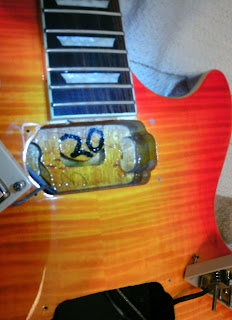Here's a "1959 Holy Grail" Les Paul standard made by Epiphone in memory of Lester Polsfuss (http://en.wikipedia.org/wiki/Les_Paul). This guitar has every feature a standard Les Paul should have except any kind of internal electrical shielding. We 'll talk about it in a moment.
The specs of this "1959" standard Epiphone guitar are amazing but there's still room for a bit of improvement. Check its original specs here:
Body: mahogany
Top: Carved hard maple cap with AAA flame maple veneer
Neck: mahogany
Neck Shape: 1950s rounded “D” profile
Neck Joint: “Deep-Set”, glued-in
Trussrod: Adjustable
Scale: 24.75”
Fingerboard: rosewood with mother of pearl “trapezoid”
Fingerboard Radius: 14”
Frets: 22 medium jumbo
Neck Pickup: Gibson USA Burstbucker™ 2
Bridge Pickup: Gibson USA Burstbucker™ 3
Controls: bridge volume, neck volume, bridge and neck pickup tone controls w/Mallory-150 capacitors, Switchcraft™ 3-way toggle
Bridge: LockTone™ Tune-O-Matic StopBar
Hardware: Nickel
Machine Heads: Vintage style 14:1 ratio with “tulip” buttons
Colors: Faded Cherryburst (FC), Faded Iced Tea (FT)
Source: http://www.epiphone.com/Products/Les-Paul/1959-Les-Paul-Standard.aspx
Mods:
This particular guitar was fitted with a Seymour Duncan Custom bridge pickup. A push-pull volume pot was added in order to split the Duncan humbucker. The sound of the stock burstbuckers is classic with a medium output. Check out the relative Gibson pickup output chart here:
http://i81.photobucket.com/albums/j202/paperboy38375/pickups.jpg
Electronics:
The electronics were in a pretty good shape but there was a lot of hiss and high pitch hum coming from the guitar when I wasn't touching any grounded metallic part. The hiss and noise was there both in dual coil and single coil mode of the humbucker. I opened up the guitar and noticed that there was no shielding paint or metal foil inside the electronics and pickup cavities. Modern LP models tend to have shielded and grounded cavities to reduce hiss and hum.
Shielding:
I bought 60ml of graphite shielding paint and stripped the guitar in order to paint its cavities:
http://www.ebay.com/itm/GUITAR-CONDUCTIVE-SHIELD-SHIELDING-PAINT-60ML-/200980484698?pt=UK_Guitar_Accessories&hash=item2ecb5ed25a
Once all electronics and pickups were out of the guitar, the shielding paint was applied with a special paintbrush and let to dry for 24h. The next day the paint was clean and dry so I measured its conductivity with a digital multimeter and everything was okay. Then, I had to re-solder and install the electronics. I also added a few ground wires so that the shielding layer of paint gets an electrical contact with the ground. I also placed two pieces of aluminum tape behind the plastic cavity covers to reduce hum ever further. All six sides of an electronics cavity should be shielded and grounded in order to create a proper "Faraday cage/shield" (http://en.wikipedia.org/wiki/Faraday_cage) and get the lowest noise level possible.
The result:
Once the guitar was reassembled and set up with a fresh set of strings, it was time to test it out. There was almost no hiss at high gain settings even when I wasn't touching the ground! All the unwanted noise was gone and I could finally hear the guitar and its well balanced tone without having to deal with all any frustrating hiss. If your guitar has noise issues and no shielded cavities, it's time for shielding! All pickups (singlecoils or humbuckers) and electronics should be installed inside a properly shielded guitar cavity.
Here are a few pictures of this Epiphone '59 guitar:
-Thanos
Feel free to contact me at:
guitardreamer.gr@gmail.com
Athens, Greece
guitar-dreamer.blogspot.com
guitar-dreamer.blogspot.com
















Δεν υπάρχουν σχόλια:
Δημοσίευση σχολίου
Your comments please!